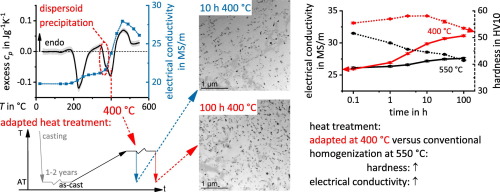当前位置:
X-MOL 学术
›
Mater. Des.
›
论文详情
Our official English website, www.x-mol.net, welcomes your
feedback! (Note: you will need to create a separate account there.)
In situ DSC investigation into the kinetics and microstructure of dispersoid formation in Al-Mn-Fe-Si(-Mg) alloys
Materials & Design ( IF 7.6 ) Pub Date : 2018-05-01 , DOI: 10.1016/j.matdes.2018.03.007 Richard H. Kemsies , Benjamin Milkereit , Sigurd Wenner , Randi Holmestad , Olaf Kessler
Materials & Design ( IF 7.6 ) Pub Date : 2018-05-01 , DOI: 10.1016/j.matdes.2018.03.007 Richard H. Kemsies , Benjamin Milkereit , Sigurd Wenner , Randi Holmestad , Olaf Kessler

|
Abstract Dispersoid strengthening in Al-Mn-Fe-Si(-Mg) aluminum wrought alloys can play an important role in applications at elevated temperatures. Fine and evenly distributed dispersoids are needed to increase alloy strength, which can be achieved by conducting an adapted homogenization heat treatment. In this work for the first time, the precipitation behavior of dispersoids in direct chill casted Al-Mn-Fe-Si(-Mg) alloys was systematically investigated in situ during heating by means of differential scanning calorimetry. In situ analysis of the phase transformation kinetics during heating and homogenization was complemented by ex situ testing of the electrical conductivity and Vickers hardness, as well as micro- and nano-structural analyses by optical light and transmission electron microscopy. The influence of the heating rate on precipitation behavior was determined by calorimetric in situ experiments, covering a wide heating rate, ranging from 0.003 to 2 K/s. The influence of 400 and 550 °C homogenization temperatures and soaking durations on hardness and electrical conductivity was also investigated. The highest dispersoid strengthening was obtained after heat treating the as-cast Mg-containing alloy at 400 °C for 3 to 10 h. Furthermore, the Mg content heavily influenced the precipitation behavior by forming β-Mg2Si precursor phases, which can act as nucleation sites for dispersoid precipitation.
中文翻译:

Al-Mn-Fe-Si(-Mg)合金弥散体形成动力学和微观结构的原位DSC研究
摘要 Al-Mn-Fe-Si(-Mg) 铝锻造合金中的弥散体强化在高温应用中起着重要作用。需要精细且均匀分布的弥散体来提高合金强度,这可以通过进行适当的均质化热处理来实现。在这项工作中,首次通过差示扫描量热法在加热过程中系统地研究了直接冷铸 Al-Mn-Fe-Si(-Mg) 合金中弥散体的析出行为。加热和均质化过程中相变动力学的原位分析由电导率和维氏硬度的非原位测试以及通过光学和透射电子显微镜进行的微米和纳米结构分析得到补充。加热速率对沉淀行为的影响由量热原位实验确定,加热速率范围很广,范围从 0.003 到 2 K/s。还研究了 400 和 550 °C 均质温度和均热时间对硬度和电导率的影响。在 400 °C 下热处理铸态含镁合金 3 至 10 小时后,可获得最高的弥散体强化。此外,Mg 含量通过形成 β-Mg2Si 前驱体相严重影响沉淀行为,该相可以作为分散体沉淀的成核位点。还研究了 400 和 550 °C 均质温度和均热时间对硬度和电导率的影响。在 400 °C 下热处理铸态含镁合金 3 至 10 小时后,可获得最高的弥散体强化。此外,Mg 含量通过形成 β-Mg2Si 前驱体相严重影响沉淀行为,该相可以作为分散体沉淀的成核位点。还研究了 400 和 550 °C 均质温度和均热时间对硬度和电导率的影响。在 400 °C 下热处理铸态含镁合金 3 至 10 小时后,可获得最高的弥散体强化。此外,Mg 含量通过形成 β-Mg2Si 前驱体相严重影响沉淀行为,该相可以作为分散体沉淀的成核位点。
更新日期:2018-05-01
中文翻译:

Al-Mn-Fe-Si(-Mg)合金弥散体形成动力学和微观结构的原位DSC研究
摘要 Al-Mn-Fe-Si(-Mg) 铝锻造合金中的弥散体强化在高温应用中起着重要作用。需要精细且均匀分布的弥散体来提高合金强度,这可以通过进行适当的均质化热处理来实现。在这项工作中,首次通过差示扫描量热法在加热过程中系统地研究了直接冷铸 Al-Mn-Fe-Si(-Mg) 合金中弥散体的析出行为。加热和均质化过程中相变动力学的原位分析由电导率和维氏硬度的非原位测试以及通过光学和透射电子显微镜进行的微米和纳米结构分析得到补充。加热速率对沉淀行为的影响由量热原位实验确定,加热速率范围很广,范围从 0.003 到 2 K/s。还研究了 400 和 550 °C 均质温度和均热时间对硬度和电导率的影响。在 400 °C 下热处理铸态含镁合金 3 至 10 小时后,可获得最高的弥散体强化。此外,Mg 含量通过形成 β-Mg2Si 前驱体相严重影响沉淀行为,该相可以作为分散体沉淀的成核位点。还研究了 400 和 550 °C 均质温度和均热时间对硬度和电导率的影响。在 400 °C 下热处理铸态含镁合金 3 至 10 小时后,可获得最高的弥散体强化。此外,Mg 含量通过形成 β-Mg2Si 前驱体相严重影响沉淀行为,该相可以作为分散体沉淀的成核位点。还研究了 400 和 550 °C 均质温度和均热时间对硬度和电导率的影响。在 400 °C 下热处理铸态含镁合金 3 至 10 小时后,可获得最高的弥散体强化。此外,Mg 含量通过形成 β-Mg2Si 前驱体相严重影响沉淀行为,该相可以作为分散体沉淀的成核位点。











































 京公网安备 11010802027423号
京公网安备 11010802027423号